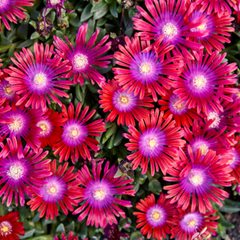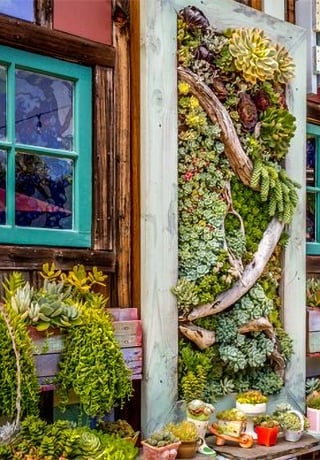Delosperma: A Growing Guide for Ice Plant
This reliable drought-tolerant succulent adds long-lasting color to the landscape
Kaleidoscope™ 'Razzle Dazzle' ice plant. Photo by: Proven Winners
Delosperma is a ground cover succulent with fleshy leaves and colorful daisy-like blooms. Plants have a dense mat-forming habit, providing an evergreen carpet year-round in warmer climates. Native to eastern and southern Africa, Delosperma thrives in heat, is drought tolerant and virtually maintenance free when given the right growing conditions.
Also known as ice plant, this hardy perennial is named for the shimmering quality of the flowers and foliage that resembles ice crystals. Delosperma is a fast grower that prefers lean, well-drained soils. These succulent plants are useful in rock gardens, perennial borders, curbside strips, containers, and waterwise gardens. Here’s how to grow ice plant and use it in your landscape.
On this page: Basics | Planting | Care | Pictures | FAQ's | Design Ideas
On this page:
- BASICS
- PLANTING ICE PLANT
- ICE PLANT CARE AND MAINTENANCE
- DELOSPERMA VARIETIES
- FREQUENTLY ASKED QUESTIONS
- DESIGN IDEAS
BASICS
Botanical name:
Delosperma spp.
Plant type:
Evergreen or semi-evergreen perennial
Zones:
Most are hardy in Zones 5-9
Exposure:
Full sun
Habit:
Dense mat-forming habit
Height/spread:
3 to 6 inches tall, 12 to 30 inches wide
Foliage:
Evergreen or semi-evergreen succulent leaves are short and pointed, occurring along the stems. Foliage comes in shades of green.
Flowers:
Small daisy-like flowers 3/4 to 2 inches wide occur in bright hues of pink, red, orange, purple, lavender, yellow, or white. Some are bicolored or multi-colored. Ice plant flowers will close up at night, in shade, or on cloudy days.
Is Delosperma poisonous?
Ice plant is non-toxic and is safe for children and pets. Mild digestive upset may occur if plants are ingested.
PLANTING ICE PLANT
When to plant:
Plant ice plant during milder weather to avoid transplant shock from extreme temperatures. In colder climates, plant in mid to late spring after the soil has warmed up. Delosperma can be planted in either spring or fall in warmer climates.
Where to plant:
Ice plants grow best on a site that receives at least 6 to 8 hours of direct sun with well-draining soil. Good drainage is essential.
How to plant:
Loosen soil in the planting area and amend with compost or other organic matter. Add lava rock, perlite, or vermiculite for more aeration. Dig a hole slightly wider and slightly shallower than the root ball. Remove the plant from its nursery container and gently tease out roots if potbound. Place in the hole so the top of the root ball is level with the surrounding soil. Fill in the hole with soil, tamp down gently to remove air pockets, and water plants thoroughly. Water regularly until plants are established. Space plants 1 to 2 feet apart, depending on the variety.
Pro Tip
"The Kaleidoscope™ series of Delosperma are true heat seekers—cascading over retaining walls and sidewalks, or trailing up to two feet in a season from hanging baskets. 'Razzle Dazzle' is a top pick for vibrant color and vigorous growth." — Andrew, Proven Winners Perennials
ICE PLANT CARE
Soil:
Plants perform best in sandy soil and can tolerate rocky or lean soil, but will fail to thrive in poorly draining soils. Provide well-draining soil with a neutral pH.
For containers, use an all-purpose potting mix especially formulated for cactus and succulents, or add perlite to the potting mix for additional drainage.
Amendments and fertilizer:
Ice plant needs little or no supplemental fertilizer. If desired, apply a thin layer of compost or all-purpose time-release fertilizer in spring.
Watering:
Delosperma prefers dry conditions and will develop root rot if overwatered. Water new plants regularly until established and provide supplemental water during prolonged heat and dry spells. Plants in containers dry out more quickly, so will need more frequent watering.
Pruning:
Delosperma may experience winter dieback, particularly in colder climates. Remove dead or damaged foliage and spent flowers in spring to tidy up plants. Plants can be lightly sheared back in late summer or early fall when finished blooming to remove seed heads and encourage a fuller growth habit. Avoid pruning too late in the growing season to allow plants to harden off for winter.
Pests and diseases:
When grown in the right conditions, ice plant is free of most pests and diseases. Pests include aphids, mealybugs, and vine weevils. Diseases include powdery mildew and root rot.
DELOSPERMA VARIETIES
FREQUENTLY ASKED QUESTIONS
Will ice plant come back every year?
Ice plant is a hardy perennial in most growing zones, coming back from year to year.
How invasive is ice plant?
Delosperma is not considered invasive, though Carprobrotus, which is a different genus of ice plant, can be invasive in parts of California, especially along the coast.
Can ice plant be a houseplant?
Ice plant is sometimes grown as a houseplant. Provide a spot indoors that receives at least 6 hours of direct sunlight or use artificial grow lights. Water sparingly, particularly during winter months.
Can ice plant stay outside in winter?
Ice plant is a hardy perennial in most regions and can overwinter outdoors. Protect containerized plants from prolonged hard freezes.
How fast do ice plants grow?
Ice plant grows quickly, doubling in size the first year, making it a good choice as a ground cover to help stem erosion.
Do ice plants need deadheading?
Ice plants can produce hundreds of flowers during the growing season. Deadheading is not necessary. Spent flowers from the previous growing season can be removed as needed in spring to tidy up plants.
LANDSCAPE IDEAS

Photo by: Darrel Guilbeau / Shutterstock
There are many ways to use ice plant in your landscape. Here’s how:
For borders and landscapes:
Grow hardy ice plant in rock gardens, beds, curbside strips or waterwise landscapes.
For slopes and hillsides:
Mass ice plant as a ground cover along a slope to help stem surface erosion.
For containers:
Ice plant can be grown in containers by themselves or alongside other plants with similar growing needs.
- Plant along a rock wall and allow it to spill over the edge for a cascade of eye-catching color.
- Add ice plant to a rock garden alongside alpine plants and other drought-tolerant perennials such as creeping thyme, saxifrage, and sedum.
- Plant in a stone trough with other low-growing succulents and alpine plants.
- Mass along a slope using varieties with the same or contrasting colors for a bright display that will also help stem surface erosion.
- Edge a waterwise curbside strip with ice plant.
- Include in a xeriscape in combination with other drought-tolerant perennials.
- Use ice plant in a hanging basket or container as a “spiller” element in combination with drought tolerant bushy and upright plants for a “thriller, filler, spiller” effect.
Companion plants: Delosperma pairs well with other drought-tolerant perennials and succulents such as creeping thyme, dianthus, lavender, lewisia, ornamental grasses, portulaca, saxifrage, sedum, sempervivum, and yucca.
RELATED:
Succulents & Succulent Garden Design
Succulent Care
Types of Succulents










